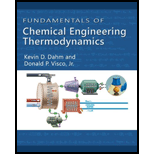
(A)
Interpretation:
The operating temperature of the condenser and the efficiency of the Carnot cycle.
Concept Introduction:
The expression to obtain the Carnot efficiency is,
Here, temperature of a low-temperature and high temperature heat reservoir is
(B)
Interpretation:
The actual efficiency of this Rankine cycle and compare it to the Carnot efficiency.
Concept Introduction:
The expression to obtain the general expression for an entropy balance equation is,
Here, time is t, mass of the system is M, specific entropy of the system is
The specific entropy of an outlet for a reversible process is,
Here, mole fraction of the system for reversible process is
The energy balance for an adiabatic steady state turbine is,
Here, specific enthalpy at inlet and outlet is
The expression to obtain the pump work is,
Here, specific volume is
The simplification equation of energy balance around whole engine is,
Here, rate of heat exchange with low temperature reservoir is
The expression of efficiency of heat engine is,
Here, net work done on turbine and pump is
(C)
Interpretation:
What effect do you expect this action had?
Trending nowThis is a popular solution!

Chapter 5 Solutions
Fundamentals of Chemical Engineering Thermodynamics (MindTap Course List)
 Introduction to Chemical Engineering Thermodynami...Chemical EngineeringISBN:9781259696527Author:J.M. Smith Termodinamica en ingenieria quimica, Hendrick C Van Ness, Michael Abbott, Mark SwihartPublisher:McGraw-Hill Education
Introduction to Chemical Engineering Thermodynami...Chemical EngineeringISBN:9781259696527Author:J.M. Smith Termodinamica en ingenieria quimica, Hendrick C Van Ness, Michael Abbott, Mark SwihartPublisher:McGraw-Hill Education Elementary Principles of Chemical Processes, Bind...Chemical EngineeringISBN:9781118431221Author:Richard M. Felder, Ronald W. Rousseau, Lisa G. BullardPublisher:WILEY
Elementary Principles of Chemical Processes, Bind...Chemical EngineeringISBN:9781118431221Author:Richard M. Felder, Ronald W. Rousseau, Lisa G. BullardPublisher:WILEY Elements of Chemical Reaction Engineering (5th Ed...Chemical EngineeringISBN:9780133887518Author:H. Scott FoglerPublisher:Prentice Hall
Elements of Chemical Reaction Engineering (5th Ed...Chemical EngineeringISBN:9780133887518Author:H. Scott FoglerPublisher:Prentice Hall
 Industrial Plastics: Theory and ApplicationsChemical EngineeringISBN:9781285061238Author:Lokensgard, ErikPublisher:Delmar Cengage Learning
Industrial Plastics: Theory and ApplicationsChemical EngineeringISBN:9781285061238Author:Lokensgard, ErikPublisher:Delmar Cengage Learning Unit Operations of Chemical EngineeringChemical EngineeringISBN:9780072848236Author:Warren McCabe, Julian C. Smith, Peter HarriottPublisher:McGraw-Hill Companies, The
Unit Operations of Chemical EngineeringChemical EngineeringISBN:9780072848236Author:Warren McCabe, Julian C. Smith, Peter HarriottPublisher:McGraw-Hill Companies, The





